
Dordrecht, historically known in English as Dordt or Dort, is a city and municipality in the Western Netherlands, located in the province of South Holland. It is the province's fifth-largest city after Rotterdam, The Hague, Zoetermeer and Leiden, with a population of 119,115.

The Cathedral of Saint Mary Major, often called Lisbon Cathedral or simply the Sé, is a Roman Catholic cathedral located in Lisbon, Portugal. The oldest church in the city, it is the seat of the Patriarchate of Lisbon. Built in 1147, the cathedral has survived many earthquakes and has been modified, renovated and restored several times. It is nowadays a mix of different architectural styles. It has been classified as a National Monument since 1910.

Lingotto is the name of a district of Turin, Italy, as well as the name of the Lingotto building in Via Nizza. It once housed a car factory built by Italian automotive company Fiat and today houses the administrative headquarters of the manufacturer and a multipurpose centre projected by architect Renzo Piano.

Frans Hals Museum - Hal is one of the two locations of the Frans Hals Museum, located on the Grote Markt, Haarlem, Netherlands, where modern and contemporary art is on display in alternating presentations. The emphasis is on contemporary photograph and video presentations, with the focus on Man and society.

Neoclassical architecture, sometimes referred to as Classical Revival architecture, is an architectural style produced by the Neoclassical movement that began in the mid-18th century in Italy, France and Germany. It became one of the most prominent architectural styles in the Western world. The prevailing styles of architecture in most of Europe for the previous two centuries, Renaissance architecture and Baroque architecture, already represented partial revivals of the Classical architecture of ancient Rome and ancient Greek architecture, but the Neoclassical movement aimed to strip away the excesses of Late Baroque and return to a purer and more authentic classical style, adapted to modern purposes.
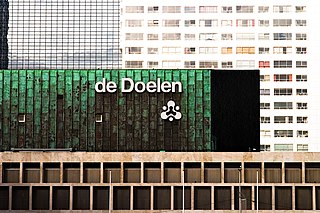
De Doelen is a concert venue and convention centre in Rotterdam, Netherlands. It was originally built in 1934 but then destroyed in 1940 during the German bombardment of Rotterdam in May 1940 at the outset of World War II. It was rebuilt in 1966, originally with one hall to which two more were added in the 1990s.

Ons' Lieve Heer op Solder is a 17th-century canal house, house church, and museum in the city center of Amsterdam, The Netherlands. The Catholic Church was built on the top three floors of the canal house during the 1660s. It is an important example of a "schuilkerk", or "clandestine church" in which Catholics and other religious dissenters from the seventeenth century Dutch Reformed Church, unable to worship in public, held services. The church has been open as a museum since 28 April 1888, and has 85,000 visitors annually.

The Proveniershuis is a hofje and former schutterij on the Grote Houtstraat in Haarlem, Netherlands.

The Old Great Square is a medieval market square located in the city centre of Turku, Finland. It is located in the II District in very close proximity to Turku Cathedral. The area was the administrative and commercial centre of Turku since the founding of the city in the 13th century up until the Great Fire of Turku.

The Old City Hall in The Hague is a Renaissance-style building on the Groenmarkt near the Grote Kerk. It is the former seat of the city's government, and remains a place where residents hold civic wedding ceremonies, and where the royal family register their family births. Other families do this at the current city hall located in the large white building on the Kalvermarkt, near the public library.

The City Hall in Delft is a Renaissance style building on the Markt across from the Nieuwe Kerk. It is the seat of the city's government as well as a popular venue for civic wedding ceremonies. Most administrative functions have been transferred to an office inside the Delft railway station building. Originally designed by the Dutch architect Hendrick de Keyser, it was heavily changed over the centuries and was restored in the 20th century to its Renaissance appearance.
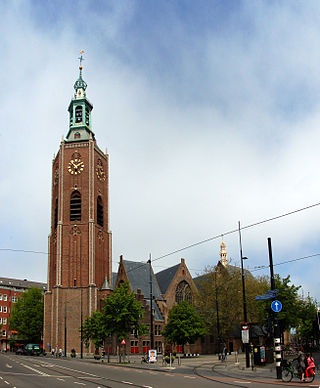
The Great Church or St. James' Church is a landmark Protestant church in The Hague, Netherlands. The building is located on the Torenstraat, named for its high tower. Together with the Binnenhof, it is one of the oldest buildings in The Hague. Members of the House of Orange-Nassau have been baptised and married there. The latest are King Willem-Alexander of the Netherlands and his daughter and heir apparent Catharina-Amalia, Princess of Orange.

The Brugse Vrije was a castellany in the county of Flanders, often called in English "the Franc of Bruges". It included the area around Bruges, and was bordered by the North Sea, the Westerschelde and the Yser river. The city of Bruges was separated from the castellany in 1127. Since then the city and the Vrije were considered as separate customary law areas. The Brugse Vrije was a rich agricultural region. It had its own burgrave, who was seated at the Burg, a square in Bruges, and became part of the Four Members of Flanders at the end of the 14th century, together with the three major cities of Ghent, Bruges and Ypres. The Brugse Vrije sat in the meetings of the States of Flanders.
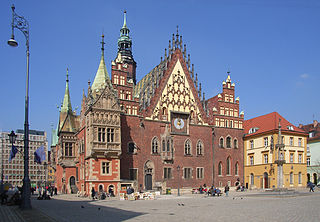
The Old Town Hall of Wrocław stands at the center of the city’s Market Square (rynek). The Gothic town hall built from the 13th century is one of the main landmarks of the city.

Pillnitz Palace is a restored Baroque schloss at the eastern end of the city of Dresden in the German state of Saxony. It is located on the right bank of the River Elbe in the former village of Pillnitz. It was the summer residence of many electors and kings of Saxony; it is also known for the Declaration of Pillnitz in 1791.
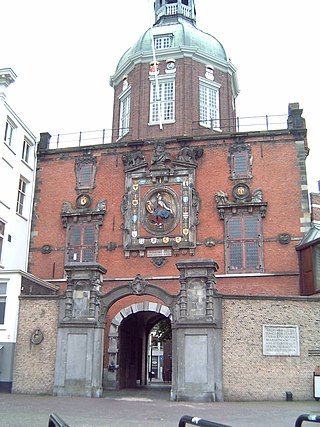
The Groothoofdspoort is a former city gate in Dordrecht that is located at the point where three rivers meet; the Merwede, the Oude Maas, and the Noord.

The City Hall in Nieuwer-Amstel is a Neo renaissance building built in 1889-1892 overlooking the Amstel. It was the seat of the city of Nieuwer-Amstel's government, but after absorption into the municipality of Amsterdam in 1896, it became a location for the Amsterdam City Archives in 1914.
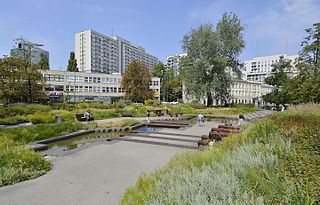
Grzybów Square is a triangular square in the Śródmieście (downtown) district of Warsaw, Poland, between Twarda, Bagno, Grzybowska and Królewska streets.
The Vischpoort or Vispoort is a late-14th-century city gate and former lighthouse in Harderwijk, Netherlands. The gate, which is located on the historical seaside of the Zuiderzee, is the only one of five gates in the city walls that remains. Between 1851 and 1947 the Vischpoort served as a lighthouse. The Vischpoort is listed as a national heritage site.

Rotterdam City Hall was built between 1914 and 1920 by Henri Evers. It is one of the few buildings in the center of Rotterdam that survived the bombing of May 14, 1940. Since 10 October 2000 it has been recognized as a Rijksmonument.



















